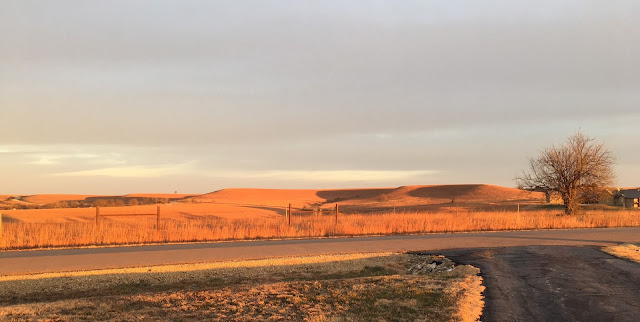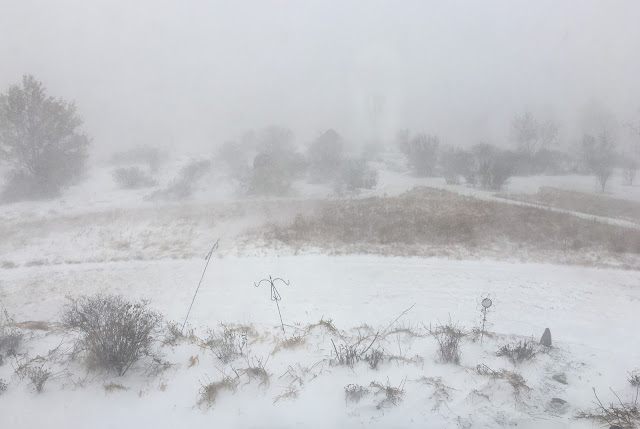(Non sequitur; has anyone else noticed that the iPhone 16 seems to have better representation of the reds than previous iPhones and digital cameras? I'm much happier with the red tones of digital pictures these days!)
Though an old gardener, I am but a young blogger. The humor and added alliteration are free.
Saturday, June 28, 2025
Hunter Tribute
Wednesday, June 11, 2025
Lambert Closse
.jpg) |
| 'Lambert Closse' |
ProfessorRoush said "sparse canes", but I really should have said "cane", as in the singular form. My specimen had an odd first growth year, putting up several weak spindly canes, and then a single long thick cane that had me worried it was a sucker from a nearby 'Dr. Huey' plant. This year, however 2-3 other healthy canes are sprouting from the base and starting to catch up to last year's prodigy.
'Lambert Closse' (formerly Ottawa 'U33') was a cross of bright yellow Floribunda 'Arthur Bell' (McGredy, 1959) with pink and the vigorous Canadian semi-climber 'John Davis', an odd match if ever there was one. The result, against all odds, is a very double flower of the clearest medium pink, borne in loose clusters and a bush reportedly hardy to Zone 3 (I saw the rose lose about 6 inches on its canes this winter here in Kansas). 'Lambert Closse' has glossy, healthy foliage and bears nonremarkable hips in Fall and Winter.Bred by Dr. Ian S. Ogilvie and Dr. Felicitas Svejda in 1983, 'Lambert Closse' is named for a French merchant, Raphaël Lambert Closse (1618-1662), who made a name for himself fighting the Iroquois and first met his wife, Elisabeth Moyen, while rescuing her from them in 1657. He was ultimately killed by the Iroquois only 5 years later, so we will leave judgement of the true quality of his tactical military skills to the historians..jpg) |
| 'Lambert Closse' open |
Tuesday, May 20, 2025
Canadian John Cabot
It is my pleasure to introduce you to 'John Cabot', introduced by Ag Canada in 1977 according to helpmefind/roses, although other sources say its introduction was in 1978). Bred by Dr. Felicitas Svejda in 1969, this rose was named after an Italian navigator and explorer (his English name was John Cabot, but he was known as Giovanni Caboto in Italy), who, in 1497, crossed the formidable Atlantic Ocean to the New World and was the first European to reach Newfoundland since the Vikings.
The 'John Cabot' of my acquaintance is a gangly, thorny, sprawling mass of a rose, with some disheveled pink-red blossoms that open quickly to their 3-inch diameter forms in clusters on short stems. Many petals have a central white streak and, in that way, the rose reminds me of a smaller 'William Baffin'. Although described to have "mild fragrance" in the entry by helpmefind/roses, I detect no hint of fragrance in the flowers of my specimen. My 'John Cabot' only bloomed once last year, in June, although it is said to have sporadic rebloom in late summer.
A Hybrid Kordesii, 'John Cabot' ((Rosa kordesii Wulff x (Masquerade x Rosa laxa)) is said to be hardy to Zone 2B. He certainly is solidly cane-hardy in winter here in Zone 5, with absolutely no dieback in the past two seasons. and has suffered no blackspot or mildew on his light green, matte foliage. He is also growing in a site where I lost the rambler 'America' to Rose Rosette Disease, but shows no signs of that monstrous disease yet. At three years of age in my garden, the arching canes top out around 5 feet tall, and the rose has a tendency to grab whatever is passing by.In Hardy Roses, Robert Osborne stated that 'John Cabot' is "one of the most important new roses for northern gardens" and that he first saw it labeled as "seedling L07." Released as a climber, I will prune and grow it as a shrub and try my best to keep it looking less "wild."
If, as you read this blog entry, you feel that I'm not that fond of 'John Cabot', you are correct. While I don't despise the rose, it has few exceptional qualities for me to favor. It IS hardy, healthy, and needs little nurturing to provide a bounty of color in its season, however, so it has earned my attention in the garden, and, as you can see on the right photo taken just after sunrise last Friday, its jarring bright pink color makes it a standout even on a cloudy day.Wednesday, May 14, 2025
Morning Vistas
Roses, from left to right, are tall 'John Cabot', crimson 'Hunter', pink 'Konigan von Danemark', and fading 'Marie Bugnet'
The irises are spectacular this year. You can see Bella running ahead to the right, sniffing the ground.
Peony 'Buckeye Belle' sits maroon-ly at the feet of bountiful 'Blizzard' Mockorange
One view of a rose bed looking east as the sun rises. The near border, left to right, is 'Leda', 'Rosalina', and 'Blush Hip'. The nearly red rose just behind those is 'Duchess of Portland'.
Front to back, these roses are pink 'Duchess de Montebello', bright red 'Survivor' with 'George Vancouver' to it's left, and behind, tall, and pink 'Lillian Gibson'.
I have been hacking around and reviving this bed and 'Lillian Gibson' looks about as poorly as I've ever seen, but I still think she deserves a photo all to herself.
As does this second 'Survivor' specimen, with mauve 'Hanza' and single 'Fru Dagmar Hastrup' following behind it.
Sunday, July 2, 2023
Weather Woes and Wrong Roses
Doesn't that look beautiful? I considered dancing naked in the rain, but realized the neighbors might talk.
In other news, I do have a number of new roses growing this summer, courtesy of the Home Depot "Minor Miracle" that I wrote about earlier and this one is one of the new ones, a fabulous florescent orange-red semi-double that screams "watch me" in a exhibitionist display of pride. On the downside, I don't know what variety it really is. Two of the labeled Home Depot 'Hope for Humanity' roses look like this and they're obviously not 'Hope for Humanity'. My best guess is that I now have two 'Morden Fireglow', although the foliage seems more glossy than I remember that rose. In its favor, the stems are red like 'Morden Fireglow' and the color is so unique, it is hard for it to be anything else. Certainly, this isn't a reborn 'Tropicana' and time and winter hardiness may reveal its secret identity. Of similar concern is that the labeled 'Rugelda' I purchased appears to be a 'Hope for Humanity' instead. The 'Morden Sunrise' and 'Zephirine Drouhin' seem correct, so they're not all labeled wrong, but 'John Cabot' hasn't bloomed and isn't acting like a climber. Who knows what I've got?I said I would end on a (semi)-high note, right? You didn't really expect a fully happy ending from this blog did you? After all the times you've been here? My mystery rose is a beautiful rose indeed and certainly provides some color to contrast the subtle daylilies, but is it really too much to expect that if I'm paying $13 or $14 for a big-box-store rose, it would be labeled correctly? How hard is that?Sunday, April 2, 2023
Minor Miracles
Sunday, December 2, 2018
Fall and Winter
 |
| 'John Cabot' |
Renewal, however, is always just around the corner in a garden. There were always bright spots, refreshing moments like the 'John Cabot' rose (photo above) trying to climb through an old sitting bench near it. The spray was half eaten away, but it still shone like the entrance to heaven from halfway across the garden. I rallied in time to purchase a couple of dozen daylily starts at the local sale and gathered the energy to water them enough to keep them alive. And the irrepressible crape myrtles bloomed on time and gave way to panicled hydrangeas and late summer shrubs in their due time.
 |
| Sweet Gum |
Fall was nice while it lasted. My young Sweet Gum, Liquidambar styraciflua (above, left), won my undying gratitude for its glowing orange fall foliage, and the prairie began to greet the sun every morning with its own display of gold and rust (below). There are many here who believe fall is the best season on the prairie, and I can scarcely find any reason to quibble.

Thursday, March 31, 2011
How Long the Rose?
 |
| 'Champlain' |
'Cuthbert Grant' 10.0 high
'Morden Ruby' 8.9 medium
'Adelaide Hoodless' 8.8 medium
'Morden Amorette' 10.0 medium
'Morden Cardinette' 10.0 medium
'Morden Centennial' 10.7 medium
'Morden Blush' 12.3 medium
'Morden Fireglow' 9.0 medium
'Martin Frobisher' 13.3 medium
'Henry Hudson' 13.4 high
'David Thompson' 12.7 high
'Charles Albanel' 11.3 high
'John Cabot' 10.3 high
'William Baffin' 10.4 high
'Henry Kelsey' 9.0 medium
'John Davis' 11.6 high
'John Franklin' 14.0 medium
'Champlain' 13.6 medium
'Alexander Mackenzie' 9.4 high
'J.P.Connell' 8.1 medium
'Capt. Samuel Holland' 12.2 high
'Louis Jolliet' 14.5 high
I know this table reproduced from Ogilvie and Arnold leaves a lot of questions for those of a scientific mindset (how many years of bloom were averaged to obtain these numbers, spraying protocols, etc), but this information from two individuals involved in the breeding of these roses is still priceless for gardeners who are choosing roses for their landscapes. Yes, I agree that it would be nice to have disease resistance ratings and bloom periods like this for various climates and locations (in Virginia versus Kansas for instance), but for now, this information is the best available and I think that it relatively fits what I see for these roses here in Kansas. 'Champlain' for instance is almost never without bloom and perhaps once or twice in a bad year I have sprayed it for blackspot, compared to 'Cuthbert Grant' who seems to have several cycles with rest periods in-between, but whom I've never sprayed for blackspot.
It also encourages me to keep better records. I grow somewhere around 150 roses at last count. Information on the dozen Buck roses I grow, for instance, might be of interest to others. If only I didn't have to earn money to support the lifestyle the missus has become accustomed to, I could just walk around Thoreau-like with a notebook jotting down the blooming periods of roses. I'm sure that someday I'll have the time. I should perhaps plan for reincarnation as a bumblebee. I'd have time to visit all the roses and the ability to sting those who annoy me. Not a bad life, eh?
.jpg)
.jpg)
.jpg)
.jpg)

.jpg)
.jpg)
.jpg)
.jpg)

.jpg)
.jpg)
.jpg)
.jpg)
.jpg)
.jpg)
.jpg)
.jpg)




.jpg)


.jpg)
.jpg)
.jpg)
.jpg)


